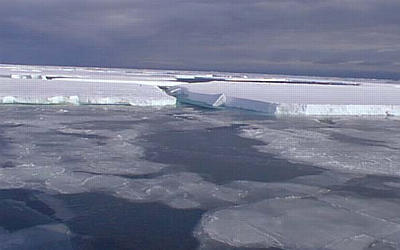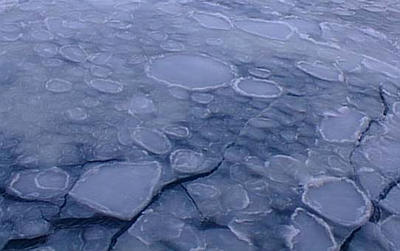24 February, 1999
February 24, 1999
Greetings from Sulzberger Bay! Today was a lot of fun. Although we only
conducted multibeam surveys during my 12 hour shift, the scenery outside
was great! We saw lots of ice today . . . and penguins! I saw both Adelie
and Emperor Penguins, and I also saw one seal (I'm not sure which species).
This afternoon we had a surprise -- it was an emergency drill! Every week
we have an emergency drill, similar to how schools are required to have
fire drills once a month. Where do you suppose we have to go for an
emergency drill? What should we take with us?
There were so many icebergs in the water today that sometimes we had to
actually change the direction of the ship. Let's take some time to look at
yesterday's question: "What's the difference between icebergs and sea ice?"
Icebergs are produced where the ice sheet meets the ocean -- at grounded
ice cliffs, glaciers, or ice shelves. When pieces of the ice calve off
into the ocean, icebergs are formed. Large tabular icebergs are calved
from the ice shelves and are usually 200 to 300 meters (650 to 1000 ft)
thick! Usually about 4/5 of an average iceberg is submerged, and only
about 1/5 can be seen above the water. Icebergs occur in many shapes and
sizes, and an average iceberg has a life expectancy of about 4 years until
it moves into warmer water and melts. When icebergs are only a few meters
across, they are called growlers. Icebergs that are tens of meters across
are called bergy bits. Giant icebergs that break off the ice shelf can be
over a hundred kilometers across! One such iceberg broke of the Amery Ice
Shelf in 1963. It was 110 by 75 kilometers (68 by 47 miles) and was
followed by satellite for almost 12 years before it broke up into pieces
that were too small to track. As this giant iceberg was carried around by
the ocean currents, it actually collided with other ice shelves and created
even more large icebergs!
Sea ice is the name given to all the ice that freezes from the sea water.
It can grow to a thickness of many feet. During the winter, the amount of
ice around the continent grows substantially. Antarctic sea ice cover
varies from a minimum of four million square kilometers in February to a
maximum of 20 million square kilometers in September. As you can see, sea
ice formation doesn't just happen all at once. As it gets colder in the
Antarctic autumn, some of the open water develops needle-shaped crystals
forming a slush. This is sometimes called frazil ice. If a film forms
across the surface, it is called grease ice. Grease ice gives the water a
matte appearance -- we were able to see some yesterday when the water was
especially calm. As the water continues to freeze into pieces, it can form
pancake ice. Typically, pancake ice is made of pieces that are less than 7
meters across. It is called pancake ice because the edges are rounded as
the waves jostle the pieces against one another. As the ice continues to
grow and thicken, the pancakes get bigger and bigger. In addition to the
freezing of sea water, snow is added to the top of the ice to help increase
it's size. If the pieces become larger than about 7 meters across, they
are called cake ice. Eventually the ice forms one solid, floating layer
which can reach a thickness of several meters. As I write this journal, I
can look out the porthole and see pancake ice beginning to form. We are
approaching autumn in Antarctica, and the sea is already beginning to
freeze.
The Nathaniel B. Palmer is built to break sea ice up to 1 meter thick at 3
knots. If we are breaking ice, the ship actually runs up on the ice and
the weight of the ship breaks it into smaller pieces. In order to break
heavy ice, the ship rams back and forth. There is also a way to make the
ship roll from side to side if necessary. We haven't had to break any
heavy sea ice since I've been aboard. Today, we have been traveling
through pack ice. Pack ice is made up of various sizes of ice pieces that
are floating with the currents. Most of the pack ice that we are seeing
was part of the solid layer of sea ice that covered this area last winter.
Since it is now late summer, the pack has broken up and is moving with the
winds and the currents. When the pieces of ice are spread apart with water
between them it is called loose or open pack. Close pack is when the
pieces of ice are pretty close together and you can't see much water at
all. Today, we have been in a lot of loose pack ice. When we go through
close pack ice, it sounds almost like a carwash inside the ship. The
closer the pack, the louder it gets! I can just imagine the sound when
they do have to ram back and forth!
Sometime during the expedition, we will be entering an area where there is
no satellite coverage. As a result, we will not be able to upload/download
email and I will note able to send out the journals and pictures. I will
continue writing them each day, and they will be mailed out as satellite
coverage allows. Please be patient . . . we're not exactly sure when this
will happen. I just wanted to let you know that it was a possiblity. I
hope that you are having a great week. I know that I am!
Kim Giesting
Latitude: 76 degrees 30 minutes South
Longitude: 155 degrees 01 minute West
Temperature: -7 degrees C
Barometer: 984.6 mb
Wind Speed: 12.9 knot
Wind Direction: 98 degrees (from the east)
Sunrise Today: 02:18
Sunset Today: 20:44

This picture was taken close about 2 hours before sunset. Can you find the penguin (black dot)?

Old sea ice is floating in the back of the picture. New sea ice is beginning to form in the front. If you look carefully, you can see a penguin (small black dot) just to the left of center.

This is pancake ice that has started to freeze together.
Contact the TEA in the field at
.
If you cannot connect through your browser, copy the
TEA's e-mail address in the "To:" line of
your favorite e-mail package.
|
